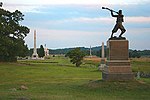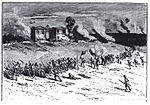Gettysburg National Museum
Defunct museums in PennsylvaniaGettysburg National Military ParkHistory of Adams County, PennsylvaniaMuseums disestablished in 2008Museums established in 1921

The Gettysburg National Museum was a Gettysburg Battlefield visitor attraction on the south border of the Gettysburg borough. Established by George D. Rosensteel after working at his uncle's 1888 Round Top Museum, the facility had an interpretive Battle of Gettysburg map using incandescent lights and was acquired by the National Park Service for use as the 1974–2008 Gettysburg National Military Park museum and visitor center after the Cyclorama Building at Gettysburg and before the Gettysburg Museum and Visitor Center.
Excerpt from the Wikipedia article Gettysburg National Museum (License: CC BY-SA 3.0, Authors, Images).Gettysburg National Museum
Cyclorama Drive,
Geographical coordinates (GPS) Address Nearby Places Show on map
Geographical coordinates (GPS)
| Latitude | Longitude |
|---|---|
| N 39.817716666667 ° | E -77.233033333333 ° |
Address
12th MA "Webster's Regiment" Bates(w) / Allen
Cyclorama Drive
17325
Pennsylvania, United States
Open on Google Maps










